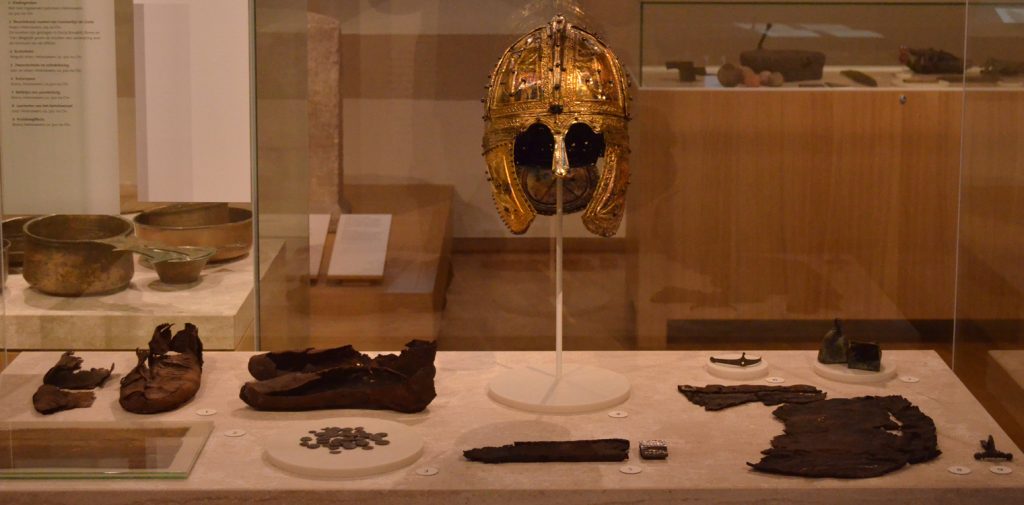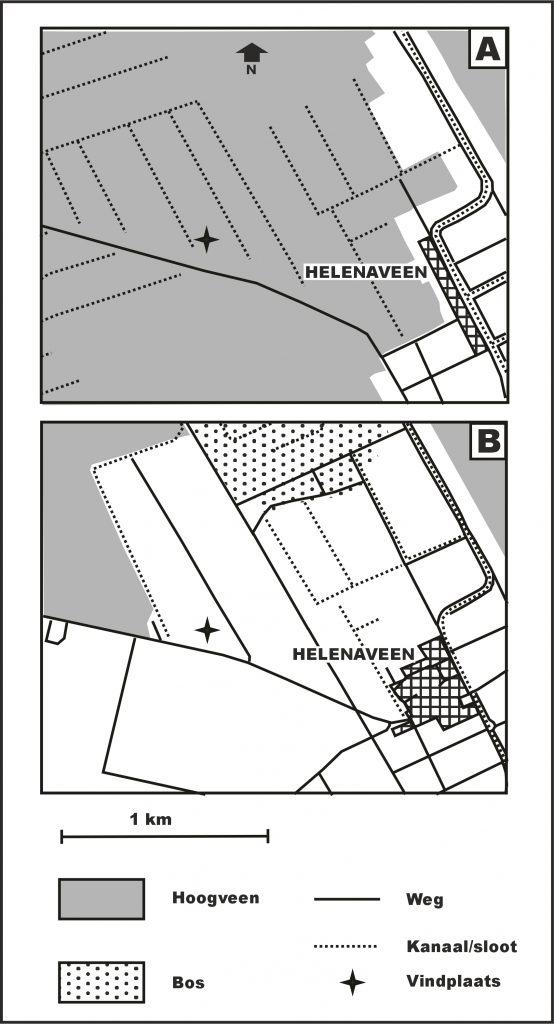Palaeoecology of a Roman helmet from the Peel region (SE Netherlands)
In 1910 a peat cutter found in the surroundings of Helenaveen in the Peel region (municipality of Deurne, southern Netherlands) a gilded Roman helmet together with various coins, a spur, a fibula, some shoes (from unmatching pairs), a sword sheather, various fragments of leather, and some other items (cf. Evelein 1911a/b; Braat et al. 1973; Pouls & Crompvoets 2006). It is one of the most important archaeological finds in the Peel region, together with the well-known Roman ornamental disc of Helden (De Grooth 1987). Since the coins date from AD 315-319 and Roman legionaries were normally paid with new coins, the material must have been deposited in the peat around 319/320 (Braat et al. 1973).
 The Roman finds from Helenaveen (municipality of Deurne), currently preserved in the Rijksmuseum voor Oudheden in Leiden (Photo: Pim de Klerk).
The Roman finds from Helenaveen (municipality of Deurne), currently preserved in the Rijksmuseum voor Oudheden in Leiden (Photo: Pim de Klerk).
The original theory was that an unfortunate Roman soldier had an accident while travelling through the bogs and drowned in the peatland (Evelein 1911a; Braat et al. 1973). The recent discovery that the helmet had been preserved in a large leather purse, however, suggests that the objects were deliberately deposited (cf. Van Driel-Murray 2000). Unfortunately, it is not possible anymore to scientifically investigate the find spot due to extensive topographical changes in the area, including the almost complete disapearance of the original peat, deep ploughing, and filling of channels.
Some small peat fragments, however, were still attached to the leather fragments. Palynological nalyses of these fragments allowed a reconstruction of the local environment around AD 320. Furthermore, original peat corings of 1920 were used in order to reconstruct patterns of peat formation.
 Location of the find spot. A: topography at the beginning of the 20th century; B: current topography
Location of the find spot. A: topography at the beginning of the 20th century; B: current topography
After a comparisson of the regional pollen signal in the samples from the find with the well-dated pollen diagram from the Ospelse Peel (Janssen & Ten Hove 1971) it was possible to date the various samples: these originate from several time-intervals between ca. 800 BCE and AD 410. This shows that the deeper parts of the find had been in contact with older peat than the higher parts of the finds, which is logical consedering the dimension of the helmet.
The pollen types from wetland plants indicate that the local peatland consisted of a transitional marginal reach between the central bog areas and the surrounding mineral grounds (lagg-zone). This environment can only have been rather shallow. Also the study of the peat corings from 1920 demonstrate that during the Roman period only thin peat layers were present at the find spot. It is, therefore, very improbable that a Roman soldier had drowned: a deliberate deposition seems much more likely, especially since the items found together with the helmet are typical votive objects for the Germanic regions of the Roman empire (cf. Slofstra & Van der Sanden 1987; Verwers 1999).
This research was carried out in close cooperation with Hans Joosten, Anja Prager and Klemens Karkow.
Publication:
Joosten, H., de Klerk, P., Karkow, K. & Prager, A. (2006): De natuurlijke context van de vindplaats. In: Pouls, J.H. & Crompvoets, H.J.G. (eds.): De gouden helm uit de Peel. Feiten en visies. Heemkundevereniging Medelo, Meijel: 53-69.
Other relevant literature:
Braat, W.C., Van Buchem, H.J.H., Zadoks-Josephus Jitta, A.N. & Leene, J.E. (1973): Der Fund von Deurne, Holland. In: Klumbach, H. (ed.): Spätrömische Gardehelme. C.H. Beck’sche Verlagsbuchhandlung, München: 51-83.
De Grooth, M.E.T. (1987): De sierschijf van Helden. Oudheidkundige Mededelingen uit het Rijksmuseum van Oudheden te Leiden 67: 67-77.
Evelein, M.A. (1911a): Een Romeinse helm uit de Peel. Oudheidkundige Mededelingen uit het Rijksmuseum van Oudheden te Leiden 5: 132-151.
Evelein, M.A. (1911b): Ein römischer Helm des Leidener Museums. Prähistorische Zeitschrift 3: 144-156.
Janssen, C.R. & Ten Hove, H.A. (1971): Some Late-Holocene pollen diagrams from the Peel raised bogs (southern Netherlands). Review of Palaeobotany and Palynology 11: 7-53.
Slofstra, J. & Van der Sanden, W. (1987): Rurale cultusplaatsen uit de Romeinse tijd in het Maas-Demer-Scheldegebied. Analecta Praehistorica Leidensia 20: 125-168.
Van Driel-Murray, C. (2000): A late Roman assemblage from Deurne (Netherlands). Bonner Jahrbücher 200: 293-308.
Verwers, W.J.H. (1999): North Brabant in Roman and Early Medieval times V: habitation history. Berichten van de Rijksdienst voor het Oudheidkundig Bodemonderzoek 43: 199-360.